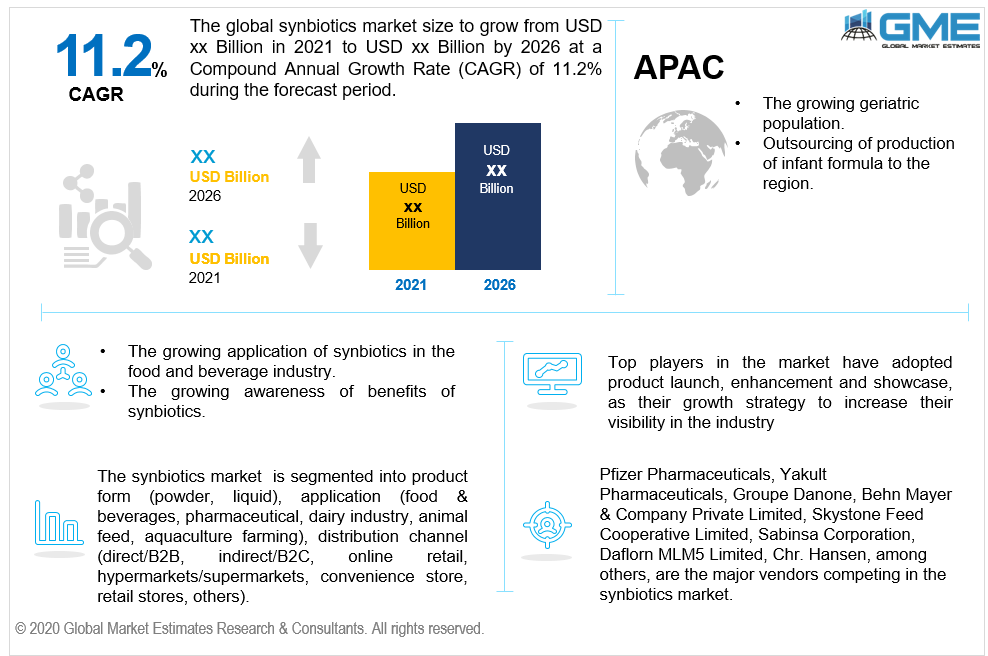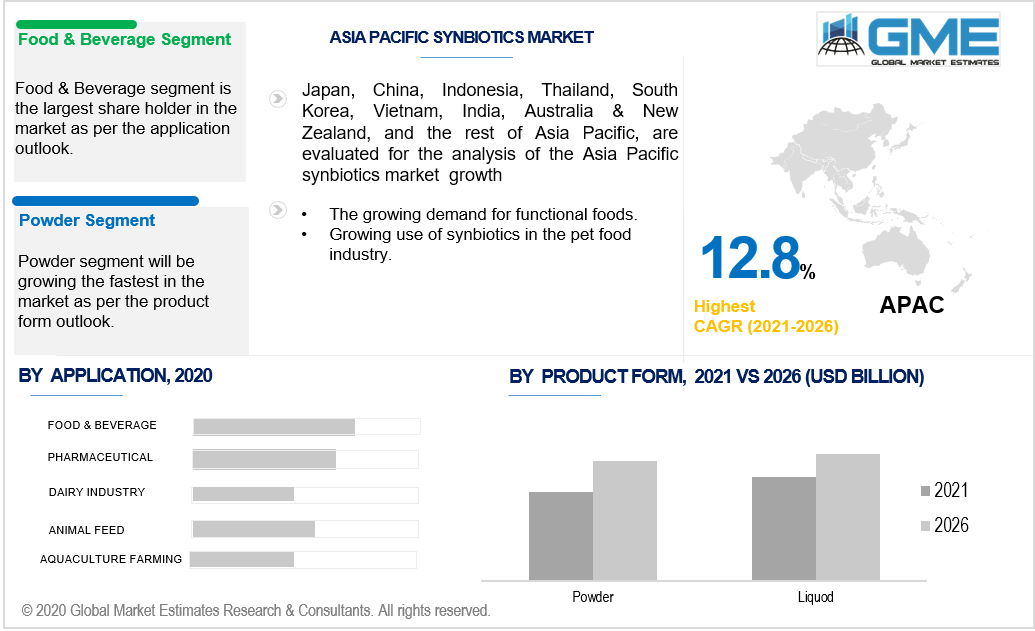
Global Synbiotics Market Size, Trends, and Analysis - Forecast To 2026 By Product Form (Powder, Liquid), By Application (Food & Beverages, Pharmaceutical, Dairy Industry, Animal Feed, Aquaculture Farming), By Distribution Channel (Direct/B2B, Indirect/B2C, Online Retail, Hypermarkets/Supermarkets, Convenience Store, Retail Stores, Others), By Region (North America, Asia Pacific, CSA, Europe, and the Middle East and Africa); End-User Landscape, Company Market Share Analysis & Competitor Analysis
Synbioticsare essentially mixtures of prebiotics and probiotics in fixed quantities that promote the growth of beneficial bacteria in the gut and stomach. These are the most frequently found bacterias in the intestines, colon, and gastronomical tract. Synbiotics enhance the digestion occurring in the stomach and supplement the benefits from the regular intake of nutritional foods. Synbiotics promote healthy digestion, reduce inflammation, and enhance the immune system of the body. Synbiotics are capable of promoting effective digestion of nutrients like calcium, phosphorous, and magnesium. They also alleviate various ailments like allergies, lactose intolerance, promote healthy cardiovascular activity, and help prevent osteoporosis. Food and beverage manufacturers are increasingly adding synbiotics to their products to have enhanced nutritional benefits and better health benefits to their consumers. Synbiotics are most commonly used inthe production of food items like cereals, nutrient supplements, chocolates, and candies. Synbiotics are also used in the pharmaceutical industries and pet foods to promote a healthier lifestyle. The dairy industry is also increasingly using synbiotics to improve fiber content in their products to improve the digestive properties. The EU recently reduced its quota on synbiotics in dairy products which is expected to increase the demand for synbiotics in the dairy industry. The growing awareness of fitness and the need for a healthy diet with proper supplements have increased the demand for synbiotics in recent years. The synbiotics market is driven by the growing geriatric population, and growing use of synbiotics in the food and beverage industry.

Based on the product form, the synbiotics market can be segmented into powder and liquid. The liquid segment is expected to hold the dominant share of the market during the forecast period. Liquid synbiotics are easier to consume and do not need to be mixed with any other food to be ingested. Liquid synbiotics are more commonly preferred by consumers and have resulted in the dominance of this segment. The powder segment is expected to register the fastest growth rate during the forecast period. Powders are easier to store and have longer shelf lives, powders are leak-resistant and do not require a lot of packaging which is increasingly preferred by manufacturers. Powders also allow the consumer to regulate the quantity of the product consumed and are becoming increasingly preferred consumers.
Based on the application, the synbiotics market can be segmented into food & beverages, pharmaceutical, dairy industry, animal feed, aquaculture, and farming. The food and beverages market is expected to hold the dominant share of the market during the forecast period. Food and beverage industries are increasingly using synbiotics in their products to boost the health benefits of their products. Synbiotics do not impart a distinct taste, odor, or color to the product which makes them very easy to be applied to food and beverage products. There is a growing demand for functional foods and beverages as people are becoming more health-conscious which has resulted in the dominance of the food and beverage segment in the synbiotics market.
Based on the distribution channel analysis, the synbiotics market can be segmented into direct/B2B, indirect/B2C, online retail, hypermarkets/supermarkets, convenience store, retail stores, and others. The hypermarket and supermarkets segment is expected to hold the dominant share of the market during the forecast period. Consumers prefer to purchase synbiotics from supermarkets and hypermarkets as they can be purchased along with their regular shopping trips for other essentials. Most supermarkets and hypermarkets have promotional offers and loyalty bonuses that are lucrative to consumers. These factors have contributed to the dominance of the hypermarkets and supermarkets segment. The online segment is expected to register the fastest growth rate during the forecast period. Online stores have various discounts running year round which helps reduce the costs of synbiotics. Online stores are also capable of serving a larger population and can even serve consumers who live in remote areas. A wide range of products of any category is available on the online stores. These stores also have ratings and reviews by other users. The ease of inline stores and their reliability is expected to increase the demand for online retail in the future.

The North American region is expected to hold the dominant share of the market during the forecast period. Consumers in the region are highly aware of the benefits of synbiotics which has resulted in the dominance of the region in the synbiotics market. Synbiotics are also increasingly present in various food and beverages and a large number of food and beverage manufacturers in the region are another factor in the dominant nature of the region. The APAC region is expected to register the fastest growth rate during the forecast period. The growing awareness of the health benefits of synbiotics and the rising number of applications in various industries is expected to increase the demand for synbiotics in the region. The region’s pet care industry is growing and the growing use of synbiotics in the pet care industry is expected to increase the demand for synbiotics in the region. The region is also seeing a rise in outsourcing of manufacturing of baby products like the baby formula to the region from other regions like the EU and North America. This is also expected to increase the demand for synbiotics in the region.
Yakult Pharmaceuticals, Pfizer Pharmaceuticals, Groupe Danone, Skystone Feed Cooperative Limited, Behn Mayer & Company Private Limited, Sabinsa Corporation, Chr. Hansen, Daflorn MLM5 Limited, among others, are the majorvendors competing in the synbiotics market.
Please note: This is not an exhaustive list of companies profiled in the report.
We value your investment and offer free customization with every report to fulfil your exact research needs.
The Global Synbiotics Market has been studied from the year 2019 till 2026. However, the CAGR provided in the report is from the year 2021 to 2026. The research methodology involved three stages: Desk research, Primary research, and Analysis & Output from the entire research process.

The desk research involved a robust background study which meant referring to paid and unpaid databases to understand the market dynamics; mapping contracts from press releases; identifying the key players in the market, studying their product portfolio, competition level, annual reports/SEC filings & investor presentations; and learning the demand and supply-side analysis for the Synbiotics Market.

The primary research activity included telephonic conversations with more than 50 tier 1 industry consultants, distributors, and end-use product manufacturers.

Finally, based on the above thorough research process, an in-depth analysis was carried out considering the following aspects: market attractiveness, current & future market trends, market share analysis, SWOT analysis of the company and customer analytics.

Tailor made solutions just for you
80% of our clients seek made-to-order reports. How do you want us to tailor yours?
OUR CLIENTS